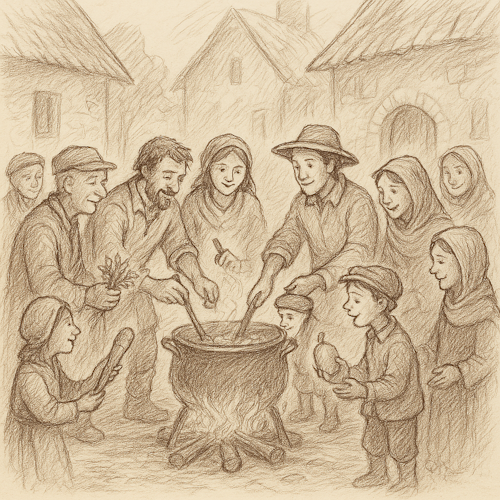Stone Soup
Illustrates Teamwork, Collaboration, Self-Organization
The parable of Stone Soup is a timeless story about shared contribution, trust, and how collective effort can lead to unexpected value. For Agile teams and organizations, it offers a powerful metaphor for collaboration, cross-functionality, and emergent outcomes

Once upon a time, in a small village worn down by war and scarcity, the people had grown distrustful and guarded. They kept what little they had to themselves, hiding food in cellars and behind doors, certain there was not enough to share.
One day, a group of travelers entered the village. Tired and hungry, they knocked on doors asking for food, but each villager refused with the same answer: “I have nothing to give.”
Undeterred, the travelers set up a pot in the village square, filled it with water, and dropped in three round stones. Curious, a few villagers wandered out to watch.
“What are you making?” someone asked.
“Stone soup,” said one traveler. “It will be delicious. Of course, it would be better with a carrot.”
A villager hesitated, then returned with a single carrot. Another followed with a potato. Someone else brought onions. Soon, others contributed herbs, meat, and salt. What began as a trickle became a stream of generosity.
By sundown, a rich, fragrant soup simmered in the pot. The whole village gathered to eat together, sharing stories, laughter, and a warm meal made from what they thought they couldn't spare.
The soup was indeed delicious. But what nourished them most wasn't just the food, it was the rediscovered sense of community.
Lessons Learned
Collaboration Creates Value
At first, no one believed they had anything to offer. The travelers didn't force cooperation, they invited it. Agile teams are most powerful when every member contributes freely, without gatekeeping or fear. Value emerges not from top-down control but from shared investment.
Psychological Safety Opens Contribution
The villagers did not share because they were afraid. It wasn't until curiosity replaced suspicion that people came forward. On Agile teams, safety is foundational. When people feel respected and heard, they begin to offer their true strengths.
Transparency Is a Catalyst
The soup pot was placed in the center of the village. It was visible. Agile frameworks emphasize transparency for this reason. Backlogs, boards, metrics, they all help teams see what's happening so they can contribute meaningfully.
Start With What You Have
The travelers didn't wait for perfection. They started with stones and water. Agile teams too can begin with thin slices, MVPs, or imperfect drafts. Getting started builds momentum and draws in collaborators.
Scarcity Is Often a Myth
The villagers believed there was nothing. But when each brought a little, it added up to something wonderful. Teams often underestimate their collective ability. Coaching helps them see how much strength already exists in the room.
Coaching Tips
- Use in Team Formation: This story works well in the early stages of team-building. Ask, “What are the stones in our pot?” and “What could we each add?”
- Reframe Resource Constraints: When teams feel under-supported, use this parable to explore how internal assets might be leveraged instead of waiting for external help.
- Visualize Collective Contribution: In retros or workshops, draw a “soup pot” and invite team members to write down what they're contributing to team success. It reinforces shared purpose.
- Connect to Cross-Functionality: Each ingredient enhanced the soup. Cross-functional skills do the same. Teams that mix perspectives build richer solutions.
Stone Soup reminds us that no one builds anything of lasting value alone. Agile teams thrive when each person brings what they have and shares it freely. What starts with curiosity can become community. What begins as a small gesture can grow into something nourishing and real.
We are not here to guard our carrots. We are here to make soup.


